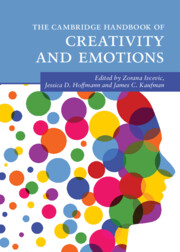Book contents
- The Cambridge Handbook of Creativity and Emotions
- Cambridge Handbooks in Psychology
- The Cambridge Handbook of Creativity and Emotions
- Copyright page
- Dedications
- Contents
- Figures
- Tables
- Contributors
- Acknowledgments
- Creativity and Emotions
- Part I Methods in the Study of Creativity and Emotions
- Part II The Development of Creativity
- Part III Emotions and the Creative Person
- 12 Emotion Traits and Creativity
- 13 Gender Differences in Creativity and Emotions
- 14 Affect in Pretend Play and Creativity
- 15 Creativity, Emotions, Emotion Regulation, and Aging
- 16 Interpersonal Relationships, Social Emotions, and Creativity
- Part IV Emotions and Creative Products
- Part V Emotions and Creativity at School and Work
- Index
- References
12 - Emotion Traits and Creativity
from Part III - Emotions and the Creative Person
Published online by Cambridge University Press: 16 February 2023
- The Cambridge Handbook of Creativity and Emotions
- Cambridge Handbooks in Psychology
- The Cambridge Handbook of Creativity and Emotions
- Copyright page
- Dedications
- Contents
- Figures
- Tables
- Contributors
- Acknowledgments
- Creativity and Emotions
- Part I Methods in the Study of Creativity and Emotions
- Part II The Development of Creativity
- Part III Emotions and the Creative Person
- 12 Emotion Traits and Creativity
- 13 Gender Differences in Creativity and Emotions
- 14 Affect in Pretend Play and Creativity
- 15 Creativity, Emotions, Emotion Regulation, and Aging
- 16 Interpersonal Relationships, Social Emotions, and Creativity
- Part IV Emotions and Creative Products
- Part V Emotions and Creativity at School and Work
- Index
- References
Summary
This chapter examines the role of emotion traits in creativity. Here, creativity is defined as a syndrome that involves attitudinal, cognitive, and behavioral components. Emotion traits most centrally affect aspects of the creativity syndrome that are manifested across situations and time. Specifically, the chapter reviews evidence of emotion traits influencing the creative decision, creative process engagement, domain-specific performance, and frequency of creative activities and achievement. The function of emotion traits is to direct attention, energize, and lower the threshold for behavior. The chapter suggests future directions in the study of emotion traits and creativity.
Keywords
- Type
- Chapter
- Information
- The Cambridge Handbook of Creativity and Emotions , pp. 223 - 242Publisher: Cambridge University PressPrint publication year: 2023

